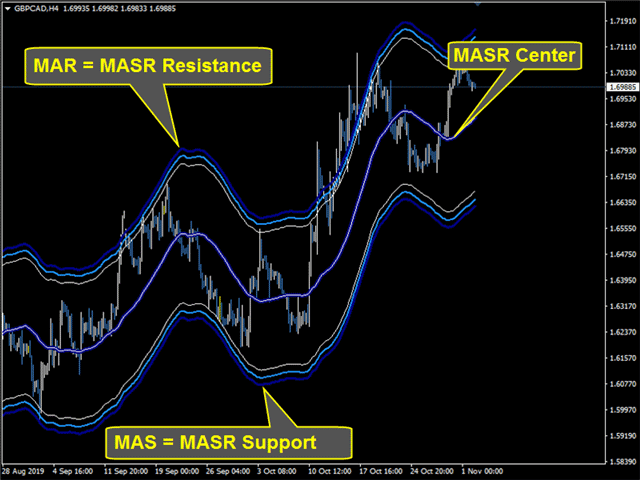Or Moving Average Support Resistance Bands.
MASR Bands indicator is a moving average
surrounded with two bands that work together as a support and resistance levels. Statistically, MASR Bands contain price candles 93% of the
time. Here is how it is calculated in steps:
1. The first step is to calculate the highest high (HHV) and the lowest low (LLV) for an X period of time.
2. The second step is to divide HHV by LLV to get how much wide is the distance between them as a percentage. I call the results of this
step MASR Filter.
3. MASR Filter = Sum ((HHV / LLV)-1) / Number of Bars
4. I call the upper band MAR which is a shortcut for Moving Average Resistance. I call the lower band MAS which is a shortcut for Moving
Average Support. The moving average in between the bands is called The Center Line.
5. MAR = MASR Center (75% x MASR Filter x MASR Center)
6. MASR Center is a moving average.
7. MAS = MASR Center – (75% x MASR Filter x MASR Center)
1. The first step is to calculate the highest high (HHV) and the lowest low (LLV) for an X period of time.
2. The second step is to divide HHV by LLV to get how much wide is the distance between them as a percentage. I call the results of this
step MASR Filter.
3. MASR Filter = Sum ((HHV / LLV)-1) / Number of Bars
4. I call the upper band MAR which is a shortcut for Moving Average Resistance. I call the lower band MAS which is a shortcut for Moving
Average Support. The moving average in between the bands is called The Center Line.
5. MAR = MASR Center (75% x MASR Filter x MASR Center)
6. MASR Center is a moving average.
7. MAS = MASR Center – (75% x MASR Filter x MASR Center)
[spoiler title=”Read More…”]
1. The first step is to calculate the highest high (HHV) and the lowest low (LLV) for an X period of time.
2. The second step is to divide HHV by LLV to get how much wide is the distance between them as a percentage. I call the results of this
step MASR Filter.
3. MASR Filter = Sum ((HHV / LLV)-1) / Number of Bars
4. I call the upper band MAR which is a shortcut for Moving Average Resistance. I call the lower band MAS which is a shortcut for Moving
Average Support. The moving average in between the bands is called The Center Line.
5. MAR = MASR Center (75% x MASR Filter x MASR Center)
6. MASR Center is a moving average.
7. MAS = MASR Center – (75% x MASR Filter x MASR Center)
Important Links:
- MASR Tools Manual: https://www.mql5.com/en/blogs/post/721889
- MASR Demo: https://www.mql5.com/en/market/product/47372
- Masr Bands EA Example: https://www.mql5.com/en/blogs/post/731139
Important Links:
- MASR Tools Manual: https://www.mql5.com/en/blogs/post/721889
- MASR Demo: https://www.mql5.com/en/market/product/47372
- Masr Bands EA Example: https://www.mql5.com/en/blogs/post/731139
- MASR Tools Manual: https://www.mql5.com/en/blogs/post/721889
- MASR Demo: https://www.mql5.com/en/market/product/47372
- Masr Bands EA Example: https://www.mql5.com/en/blogs/post/731139
What makes MASR Bands so special is the volatility index, which depends in its calculation on the range of the complete swing movement rather
than the movement from one bar to another like Average True Range or Standard Deviation calculations.
- MASR Bands do not repaint or recalculate its results.
- Well-designed parameters to help the user easily navigate between them.
- Sound, Mobile notification and email alerts depending on user choice.
- MASR Bands code is revised to make sure that it will not consume the user’s PC memory.
1. MASR INPUTS
- MASR Candles. number of candles used in calculations. The default is 40. If less than two, MASR Bands
will be terminated, an alert message will pop up on the screen. - MASR Moving Average Method. Average calculation method. Default is Simple.
2. MASR ALERTS
- Show Arrows





